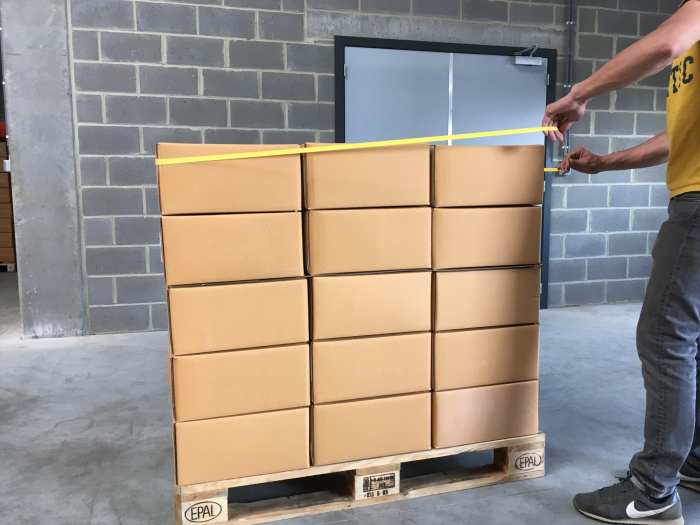Banding on a pallet serves to secure and stabilize loads, ensuring their safe and efficient transport. This technique involves wrapping a banding material around the pallet, creating a secure and stable unit. The use of banding has become increasingly prevalent in various industries, offering numerous advantages and cost-effectiveness.
Banding pallets provides several benefits, including preventing shifting and damage to goods during transportation. It also enhances the overall stability of the load, reducing the risk of accidents and ensuring the integrity of the products.
Functionality of Banding on Pallets

Banding on pallets plays a crucial role in securing and stabilizing loads during storage and transportation. It ensures that products remain intact and organized throughout the supply chain, minimizing damage and loss.
Banding involves wrapping a strong, flexible material around the pallet and its contents, creating a secure bundle that prevents shifting or toppling. This stability is particularly important for tall, heavy, or fragile items that are prone to movement or damage.
Types of Banding Materials
Various types of banding materials are available, each with its own strengths and applications:
- Polypropylene (PP) Banding:PP banding is a cost-effective and lightweight option, ideal for general-purpose applications. It offers moderate strength and flexibility, making it suitable for securing lighter loads.
- Polyester (PET) Banding:PET banding is known for its high strength and durability. It can withstand heavier loads and is resistant to moisture and chemicals, making it ideal for demanding applications in outdoor or corrosive environments.
- Steel Banding:Steel banding provides exceptional strength and is commonly used for securing heavy machinery, construction materials, and other industrial loads. It is not as flexible as PP or PET banding but offers the highest level of load retention.
Benefits of Banding on Pallets

Banding on pallets provides numerous advantages for transportation, ensuring the stability and protection of goods during transit. By securely binding the items together, banding prevents shifting and damage, reducing the risk of product loss or damage.
Industries Commonly Using Banding
Industries that commonly use banding for palletized shipments include:
- Construction materials (e.g., bricks, lumber)
- Food and beverage
- Pharmaceuticals
- Electronics
- Automotive parts
Methods of Banding Pallets

Pallet banding is a crucial step in securing and stabilizing goods during storage and transportation. There are several methods used for banding pallets, each with its own advantages and disadvantages. The choice of banding method depends on various factors, including the size and weight of the pallet load, the required level of stability, and the available budget.
Manual Banding Machines
Manual banding machines are operated by hand and require physical effort to apply the banding material. They are typically used for low-volume applications or when precision and flexibility are required. Manual banding machines are relatively inexpensive and easy to use, making them a suitable option for small businesses or occasional banding needs.
Automatic Banding Machines, Banding on a pallet serves to
Automatic banding machines are powered by electricity or compressed air and automate the banding process. They are ideal for high-volume applications where speed and efficiency are critical. Automatic banding machines can be programmed to apply banding material with specific tension and spacing, ensuring consistent and secure banding.
However, they are more expensive than manual banding machines and require regular maintenance.
Factors to Consider When Choosing a Banding Method
- Pallet Load Size and Weight:The size and weight of the pallet load determine the required banding strength and tension. Heavier or larger loads require stronger banding material and higher tension to ensure stability.
- Required Stability:The level of stability required depends on the nature of the goods and the intended handling conditions. Goods that are fragile or susceptible to movement require more secure banding to prevent damage during transportation.
- Budget:The cost of the banding machine and banding material should be considered when choosing a banding method. Manual banding machines are generally more affordable, while automatic banding machines offer higher efficiency but come with a higher price tag.
Best Practices for Banding Pallets
To ensure the stability and integrity of banded pallets, proper banding techniques are essential. Here are some best practices to follow:
Determining the Correct Tension and Spacing
- The tension of the banding should be tight enough to secure the load but not so tight that it damages the products or the pallet.
- The spacing between the bands should be even and consistent, ensuring that the load is evenly distributed and stable.
- Consider the weight and size of the load when determining the appropriate tension and spacing.
Ensuring Stability and Integrity
- Use high-quality banding material that is appropriate for the type of load and environment.
- Apply the banding in a criss-cross pattern to distribute the force evenly and prevent the load from shifting.
- Secure the banding tightly to the pallet to prevent the load from slipping or falling off.
- Inspect the banded pallets regularly to ensure that the banding remains intact and secure.
Environmental Considerations
Banding materials, like any other packaging component, have an environmental impact. It’s crucial to consider the sustainability of these materials and adopt practices that minimize waste and promote eco-friendliness.
Reducing Waste and Promoting Sustainability
Reducing waste in banding practices involves using the appropriate amount of banding material and recycling or reusing it whenever possible. Additionally, choosing biodegradable or recyclable banding options helps reduce the environmental footprint.
Biodegradable and Recyclable Banding Options
Biodegradable banding materials, such as paper or plant-based plastics, break down naturally over time, reducing their environmental impact. Recyclable banding materials, like steel or plastic, can be processed and reused, conserving resources and minimizing waste.
Banding on a pallet serves to ensure the stability of the load during transportation. To learn more about the history and significance of banding, check out the American Yawp Chapter 3 Notes . This resource provides a comprehensive overview of the development of transportation systems in the United States, including the role of banding in securing cargo.
Cost-Effectiveness of Banding: Banding On A Pallet Serves To

Banding pallets offers numerous cost-effective advantages compared to alternative securing methods. Not only is banding more economical, but it also streamlines operations, leading to significant savings in time and labor costs.
Long-Term Savings
While banding materials may have a higher upfront cost than other methods, they provide substantial long-term savings. Banding securely stabilizes loads, reducing product damage and the need for costly replacements. Additionally, the durability of banding materials ensures multiple uses, further reducing expenses.
Time and Labor Savings
Banding pallets is a highly efficient process that saves time and labor. The use of automated banding machines minimizes manual labor and increases productivity. By eliminating the need for time-consuming processes like wrapping and securing with straps, banding significantly reduces overall handling time.
Return on Investment
Investing in banding equipment and materials provides a high return on investment. The cost savings from reduced product damage, increased efficiency, and extended material lifespan far outweigh the initial investment. Companies that adopt banding solutions often experience a significant boost in their bottom line.
Top FAQs
What are the different types of banding materials available?
There are various types of banding materials, including steel, plastic, and textile. Each material offers unique strengths and characteristics, making it suitable for different applications.
How do I determine the correct tension for banding?
The correct tension for banding depends on the load weight, pallet size, and banding material used. It is important to follow the manufacturer’s guidelines to ensure proper tension and stability.
What are the environmental considerations for banding materials?
Some banding materials, such as plastic, can have an environmental impact. Biodegradable or recyclable banding options are available to reduce waste and promote sustainability.